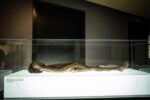Seba Kurtis – Thicker than water
.jpg)
L’opera di Seba Kurtis è da sempre dedicata alla condizione dei migranti – in particolare quelli privi di documenti – e alle conseguenze dell’immigrazione, che rappresentano una questione centrale nelle dinamiche della società contemporanea.
Comunicato stampa
L’opera di Seba Kurtis è da sempre dedicata alla condizione dei migranti – in particolare quelli privi di documenti – e alle conseguenze dell’immigrazione, che rappresentano una questione centrale nelle dinamiche della società contemporanea.
L’artista argentino, che ha vissuto in prima persona questa drammatica esperienza, fotografa persone che si sono sradicate dai propri paesi d’origine, e nei luoghi dove abitano ne rintraccia, attraverso segni e oggetti, la memoria, la situazione presente, le aspirazioni future.
Il suo lavoro non è narrativo, ma vuole piuttosto sondare la parte invisibile del fenomeno ed evocare le implicazioni più profonde di questa condizione umana. La manipolazione dei negativi, con cui le immagini vengono in parte cancellate o alterate, agisce come metafora di una violenza psicologica, e crea una tensione tra la superficie dell’immagine e lo spazio del reale.
“Thicker than water” è un progetto inedito realizzato appositamente per Fotografia Europea a Manchester, città inglese dove Kurtis vive, famosa per il suo importante passato industriale e oggi per la vivacità della scena creativa. Kurtis esplora la complessità del concetto di comunità concentrandosi sia sugli stranieri regolari, che stanno costruendo la propria nuova vita lontano dal paese natale, sia sulla situazione difficile e paradossale di chi legalmente è un immigrato irregolare, un residente a termine, sebbene sia cittadino di fatto nella vita di tutti i giorni, con forti legami ai luoghi e alle persone.
Ne sono nate due serie di immagini complementari. Gli stranieri comunitari, per lo più di paesi dell’Est, sono stati ritratti in modo chiaro e diretto. Gli altri, provenienti da paesi extraeuropei, sono stati fotografati in modo da restituire la condizione di invisibilità che sono costretti a subire: ispirandosi allo “Heartbeat human detector”, un sofisticato sistema per individuare la presenza di clandestini nei camion tramite il rilevamento di battito cardiaco, l’artista ha utilizzato uno scanner per estrarre dai negativi l’immagine appena percepibile delle persone ritratte.
Seba Kurtis (Argentina, 1974) è cresciuto a Buenos Aires sotto un regime di dittatura militare. Ha studiato giornalismo ed è stato un attivista politico. Nel 2001 l’Argentina cadde in una gravissima crisi economica e politica: fu costretto a partire per l’Europa e rimase in Spagna come immigrato clandestino per più di 5 anni. Questa esperienza è divenuta la principale fonte di ispirazione per il suo lavoro: un’esplorazione delle dinamiche all’origine dell’immigrazione irregolare e del conseguente impatto sulla cultura, la società e l’individuo. Ora vive in Inghilterra.
The work of Seba Kurtis has always focussed on the condition of migrants, particularly those without documents, and the consequences of immigration, a key issue in the dynamics of contemporary society.
The photographs of the Argentine artist – who has experienced this dramatic condition at first hand – portray people uprooted from their home countries and identify within the places where they are living the persistent signs and traces of the past and of their memories.
His work is not narrative, but seeks rather to explore the invisible aspect of the phenomenon and to evoke the deepest implications of this human condition. His handling of the negatives, whereby the faces and objects are partly erased or altered, acts like a metaphor of a psychological violence, and creates a tension between the surface of the image and the space of the real.
Thicker than water, realized specifically for Fotografia Europea, was produced in Manchester, the British city where Kurtis now lives, renowned for its significant industrial past and currently known for its vibrant creative scene. Kurtis explores the complexity of the concept of community by concentrating on the one hand, on legal foreigners who are building a new life for themselves far from their home
countries, and on the other, on the difficult and paradoxical situation of those who are de facto citizens in their everyday life, with strong bonds with people and places, but are still irregular in terms of their legal status, fixed-term citizens in fact. The former, who are foreigners from within the EU, are portrayed in a clear and direct manner; the latter, from outside the EU, have been photographed in
such a way as to convey the condition of invisibility they are forced to endure: their facial traits, only just detectable in the negatives, have been identified by means of a scanner, in exactly the same way as is done with today’s sophisticated technological equipment which can track down illegal immigrants hiding in trucks by detecting their heartbeat.
Seba Kurtis (Argentina, 1974) grew up in Buenos Aires under a dictatorship regime. He studied journalism and was a political activist. In 2001, Argentina fell under economical and political crisis. He left for Europe and remained in Spain as an illegal immigrant for over 5 years. This experience became the main inspiration for his work, an exploration of the dynamics behind irregular migration and the resultant impact on culture, society and the individual. Now he lives in the UK.



